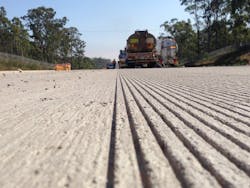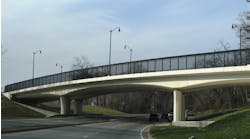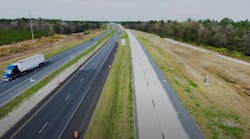Australia’s Roads and Maritime Services (RMS) recently constructed several test sections utilizing diamond saw-cut textures on their concrete pavement as part of a continued effort to minimize tire-pavement road noise. The completed research has resulted in the development of a low-noise-diamond-grinding (LNDG) surface texture, which can now be used on the most traveled concrete pavements in New South Wales (NSW). LNDG is a newly coined term by the RMS for a modified next-generation concrete surface (NGCS).
The NGCS was developed in the U.S. and, based on U.S. test results, is the quietest concrete pavement surface texture. The NGCS consists of diamond grooving a surface using 3.2-mm-wide longitudinal grooves saw-cut to a depth of 3-5 mm at 12.5- to 16-mm centers. Prior to diamond grooving, the surface is flush ground with 3.2-mm-wide blades with 0.9-mm spacers, resulting in a very fine, corduroy-like surface finish. These optimized textures are created using conventional diamond-grinding equipment.
According to a paper presented by RMS Engineers at the Australian Society for Concrete Pavements (ASCP) Concrete Pavements Conference 2013, increasing urbanization along road corridors, combined with environmental noise legislation, has led to a need for more expensive asphalt pavements in noise-sensitive areas within NSW. As an alternative to using asphalt, the RMS is pursuing LNDG on concrete pavements, because it offers cost effectiveness and low maintenance combined with low noise. Conventional diamond grinding (CDG) has been successfully used in NSW since 2009 for the purpose of reducing pavement roughness and increasing skid resistance on existing concrete pavements, but the noise attenuation provided by conventional diamond grinding was similar to that of dense-graded asphalt, and the RMS was seeking further noise reduction.
The International Grooving and Grinding Association (IGGA) recommends that newly constructed pavement have a roughness count less than or equal to 30 National Association of Australian State Roading Authorities (NAASRA) counts (equal to an IRI of 1.2 meters/km) to minimize the tire-pavement noise emissions. If the new pavement is too rough, the IGGA recommends a flush-ground pass before grooving the LNDG treatment to allow uniform groove depths to be formed in the final treatment phase.
The first of the RMS’s three trials consisted of NGCS sections located on the New England Highway on an existing jointed plain concrete pavement (JPCP) and took place in February 2012. In an effort to minimize costs, the RMS experimented by constructing additional trials along a section of the new Hunter Expressway using a modified NGCS surface. This trial was constructed omitting the typical NGCS flush-grind step and instead utilized longitudinal grooving on an untrafficked, hessian-dragged JPCP. This surface is now referred to as LNDG by the RMS. The diamond-grinding contractor for all three trials was Seovic Civil Engineering Pty. Ltd.
Road noise tests, as well as skid-resistance and ride-quality tests, were carried out according to RMS procedures. The results indicate a potential noise outcome ranging up to 3 dB(A) quieter than densely graded asphalt. Noise test results achieved for the LNDG sites in NSW are compatible with those reported for the same pavement surface treatment in the U.S. Skid-resistance outcomes show a range of 50 to 75 when measured using a SCRIM device, which is common to concrete pavements with tining in NSW. The texture depth of LNDG is on the order of 1.1 to 1.6 mm (with the groove depth varying from 3 to 5 mm), assuring that this pavement provides an appropriate margin of safety against hydroplaning. Furthermore, the high consistency of the grooving depth and alignment indicated repeatable results with a narrower band of deviation than other pavement surfaces.
A comparison between pavement costs conducted by the RMS on 10 sets of tendered rates across seven major NSW road projects consistently demonstrates that JPCP costs 19% less than continuously reinforced concrete pavement (CRCP), which in turn has a lower cost than full-depth asphalt. The LNDG surface treatment costs significantly less than placing an asphalt-wearing course. In NSW, the average initial cost of JPCP with LNDG surfacing is $138/sq meter and $174/sq meter for CRCP with stone-matrix asphalt (SMA) surfacing. Thus, for the Hunter Expressway’s 4.4-km section of dual-carriageway, noise-sensitive pavement, the savings gained from utilizing LNDG on PCP instead of SMA on CRCP (the current practice for low-noise highways) was $3.2 million. An estimated capital cost savings in the order of $720,000/km of dual carriageway can be realized on future projects.
Existing diamond-grinding specifications in NSW are not applicable for LNDG; therefore, a draft RMS specification was prepared and used for the three trial sites. Using the lessons learned at those trial sites, an interim RMS specification was generated and published.
“Being a new type of texture, there was a steep learning curve for both the grinding contractor and the RMS. Observations made during the LNDG process were used to assist in improving the specification and making sure that a high-quality outcome continued,” said Jason Seovic, grinding manager with Seovic Civil Engineering.
“With a ride count less than 30 NAASRA, it was determined by RMS in the final trial that a flush grind was unnecessary prior to grooving,” Seovic continued. “However, it became quickly apparent that any specific areas above this benchmark smoothness created too much variation in the groove depth and must be flush ground first, prior to grooving. For everyone concerned, a high importance was placed on the aesthetics of the final product. Keeping the groove width consistent between passes was challenging, but the end result made all the attention to detail worthwhile.”
“When the IGGA had first envisioned the noise-reducing surface referred to as NGCS, we had hoped that public agencies would embrace the technology and work to improve it over time. The RMS has shown tremendous interest and initiative and we are proud to have been a part of this development,” said John Roberts, executive director of the IGGA. R&B



